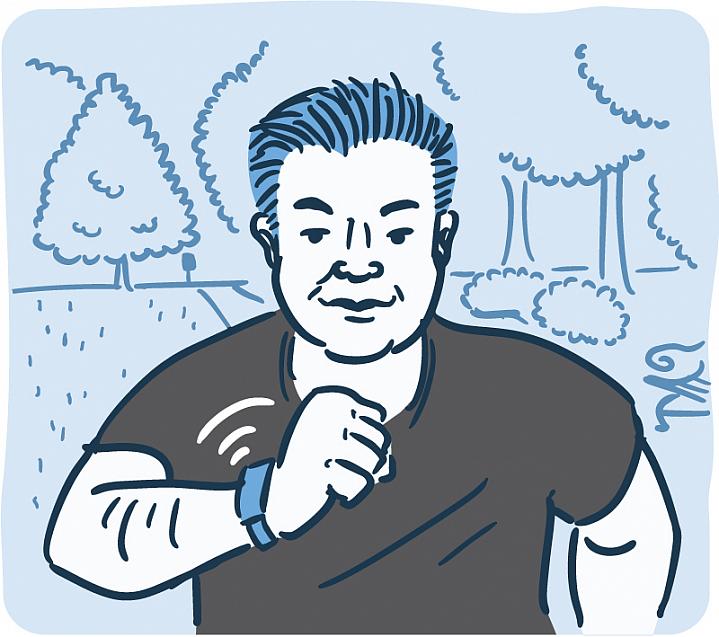Biosensors and Your Health
What’s Your Body Trying to Tell You?

Your body alerts you to many aspects of your health. Your stomach growling tells you when to eat. A powerful yawn lets you know you’re tired. Your body gives off many other valuable signals, but requires technology to detect them. Scientists are looking for new ways to track and use your body’s signals to improve your health and manage disease.
Physical activity trackers and step counters are now helping people develop and maintain healthy habits. These devices have also opened doors for people to participate in health research. Now, researchers are designing more advanced devices called biosensors that measure biological, chemical, and physical signs of health.
“The variety of biosensors used by researchers, clinicians, and people from every walk of life is growing,” says Dr. Šeila Selimović, a biosensors expert at NIH. “Some speed up test results so treatments can be started promptly. Others provide the benefits of continuous monitoring of health conditions. [Biosensors] function in fascinating ways. [They use] chemical attraction, electrical currents, light-detection systems, and compact wireless-sensing technologies.”
The mercury thermometer is one of the earliest biosensor technologies used in medicine. In modern thermometers, mercury has been replaced by safer temperature-sensitive probes. But the goal is still the same: to detect changes in your body temperature.
Another common biosensor used at home is the pregnancy test. Home pregnancy tests use color-changing strips to detect pregnancy hormonesSubstances produced in one part of the body to signal another part to react a certain way. in urine. Pregnancy tests are still done in doctor’s offices. But the home test has become a reliable alternative since it was first introduced more than 40 years ago.
The rapid strep test is another commonly used biosensor. If you have a sore throat, your doctor may want to use one to test for bacteria called streptococci. The rapid strep test can provide results from a swab of the back of your throat in a few minutes—with 95% accuracy. Your doctor may still send a throat swab to a lab to confirm a positive test result. But they can use the rapid test results to start treatment immediately.
In parts of the world where public health care isn’t readily available, researchers hope to introduce rapid tests for people living in remote regions to test for infections like influenza, HIV, and hepatitis C. New biosensor technologies can now be combined with smart phone cameras and wireless signaling. These advances make health tests more portable and affordable than lab-based equipment.
Biosensors can also be used to continuously monitor a health condition. Blood-oxygen monitors are now found throughout hospitals and in patients’ homes. These devices detect changes in the level of oxygen in the bloodstream. A rapid drop in oxygen can cause brain injury and requires quick medical attention. Blood oxygen monitors are ideal for people with lung and heart conditions, those undergoing anesthesia, or those being treated in intensive, neonatal, or emergency care. Other biosensors can be used to continuously monitor your blood sugar levels (for managing diabetes), blood pressure, or heart rate.
Flexible sensors are making even more types of monitoring possible. A team of engineers, led by Dr. Patrick Mercier and Dr. Joseph Wang at the University of California San Diego, is developing a flexible sensor that measures blood alcohol levels. It looks like a temporary tattoo. The sensor releases a sweat-promoting chemical into the skin and detects alcohol in the sweat. The sensor then sends the information wirelessly to a laptop or mobile device. Similar devices are being developed by other groups to monitor cystic fibrosis and other diseases and conditions.
At the University of Minnesota, a group of researchers led by Dr. Michael McAlpine has developed inks for 3-D printing sensors that are flexible, stretchable, and sensitive. These sensors can be used to detect human movements, such as flexing a finger. They can be printed directly onto skin and used to detect body signals, like a pulse. They can also detect chemicals in the environment and be used to warn of hazards.
NIH also supports research to use sensors to gather data about environmental and other factors involved in childhood asthma. These sensor systems monitor what children are exposed to and their body’s reactions. For example, Dr. Zhenyu Li, a biomedical engineer at George Washington University, is developing a sensor that can be worn on a child’s wrist to detect formaldehyde, an air pollutant that can trigger asthma.
“Researchers don’t have tools at the moment that can monitor environmental triggers, physiological responses, and behavior without interrupting normal activities,” Li says. There are many different asthma triggers, he explains. He expects to have a wearable sensor prototype that he and his clinical partners can begin testing with patients. He’s also working on a device that can be placed in a child’s home to detect multiple air pollutants, like those found in tobacco smoke and some manufactured wood products, such as flooring and furniture.
Biosensors can be placed inside your body as well. Dr. Natalie Wisniewski, a biomedical engineer at a medical device company in San Francisco called Profusa, is developing miniature sensors that can be injected under the skin. These sensors automatically track chemicals in your body without drawing blood. They continuously scan multiple factors at once. Normally, you need to stay in a hospital to have your body chemistry continuously monitored. With this technology, information about the chemicals in your body could be accessed around the clock, from anywhere.
Once placed under the skin, such biosensors can last for months to years. They can monitor various body functions through chemical changes. All this information can be collected on a cell phone app and shared with your physician, a caretaker, or anyone else you choose.
“Health sensors have the potential to dramatically improve the way we practice medicine and shift the focus away from reactive treatments to preventive maintenance,” Wisniewski explains.
Biosensors are quickly becoming part of our normal health care routines. New sensor technologies are opening avenues to better health. Researchers are working to develop the biosensors of tomorrow. These could provide access to better health in ways we can’t yet imagine.
NIH Office of Communications and Public Liaison
Building 31, Room 5B52
Bethesda, MD 20892-2094
nihnewsinhealth@od.nih.gov
Tel: 301-451-8224
Editor: Harrison Wein, Ph.D.
Managing Editor: Tianna Hicklin, Ph.D.
Illustrator: Alan Defibaugh
Attention Editors: Reprint our articles and illustrations in your own publication. Our material is not copyrighted. Please acknowledge NIH News in Health as the source and send us a copy.
For more consumer health news and information, visit health.nih.gov.
For wellness toolkits, visit www.nih.gov/wellnesstoolkits.



